| |
|
|
|
|
Half-Bred Family Quick Links
|
|
|
|

|
|
|
|
|
Family B-1: Roseden Mare
 |
This was a highly successful family of very good flat racers and some excellent steeplechasers, debarred from the stud book because the Roseden mare's female line could not be traced, and because Spartacus, who appears early in the family pedigree, was explicitly stated to be out of a half-bred mare, Mrs. Dawdle (born in 1794). The GSB included some foals of two stallions in this family -- Duc-an-Dhurras and Mayboy -- with notes regarding their half-bred ancestry, and Mrs. Dawdle and her progeny are also listed in the GSB, but despite agitation in 1913 and again in 1918 by the Irish Horse Breeders, Owners, and Trainers' Association to have the family admitted to the GSB, based on the success of some of its best members -- Clorane, Prospector, and Shogun -- Weatherby's declined admittance.
Roseden (a son of Derby winner Archduke, son of Sir Peter),) was bred in Yorkshire's North Riding in 1803, and later sent to Ireland where he stood at the stud of Sir James Newcomen, Carrickglass, Co. Longford. The Roseden mare was bred to Whitenose (1806), a winner in England and a son of Don Quixote (by Sir Peter, and out of Cecilia, by Sir Peter), who had been sent to Lord Fitzwilliam's Irish estate in County Wicklow, getting an unnamed daughter, in-bred to Sir Peter, apparently his only traceable offspring. The Whitenose daughter was bred to a non-winning racehorse Spartacus (1808), bred by Denis Daly in Ireland; Spartacus was by Swordsman (1796), a winner of seven King's Plates and other races, bred by Mr. Whaley of Whaley Abbey, Co. Wicklow; Swordsman was by a son of the good English racehorse later celebrated Irish sire Prizefighter, by Florizel. The dam of Spartacus was Mrs. Dawdle, a winner of a King's Plate at the Curragh in 1799, and sister to a famous Irish runner, Dawdle, both by Master Bagot and out of Twilight (Family 74), a mare whose antecedents are not noted in the General Stud Book. The result of the Whitenose mare - Spartacus union was the chestnut filly Vanity, born sometime between 1825 and 1830. Thus Vanity's second dam in tail-female was a mare by Roseden, whose antecedants could not be traced, and her sire's dam, Mrs. Dawdle, may have been half-bred.
Vanity produced two known daughters, the bay Calamity, by Vampyre, a son of Dandy, and the chestnut Luna, by well-known Irish stallion Harkaway. Calamity, born around 1840 and apparently unraced, bred two good winners in Duc-an-Dhurras and Garibaldi (by Faugh-a-Ballagh), and three daughters that bred on (see Duc-an-Dhurras below). Luna, born in 1845, won three good steeplechases, and in the stud of C. Massey in Co. Tipperary bred three youngsters; her son, Fairy Saint, became a sire of steeplechasers and hunters in Co. Clare; her daughter, Larkaway, won six steeplechases at ages four and five, and bred six winners, including Grand National steeplechase winner Come Away (see below), and three daughters that bred on.
Larkaway's unraced daughter by Xenophon, bred five winners over fences, including Greek Girl, winner 19 steeplechases, including the Prince of Wales' Plate twice, the Dunboyne Plate, the Valentine and Great Sandown steeplechases, and was second to Red Prince II (later a noted sire of chasers) in the Lancashire Handicap, giving him almost 2 stone. Larkaway's unnamed daughter by Cambuslang, a sister to Come Away, was second dam of three winners over fences, including the Ascetic son Hill of Bree, winner of ten steeplechases.
Larkaway's daughter May Day, by Stockwell son Uncus, another noted sire of chasers in Ireland, was bred by Captain Gubbins at his famous Knockany Stud, Kilmallock, Co. Limerick; Larkaway was subsequently sold, and her produce after 1879 were bred by Harry Beasley at Eyrefield House at the Curragh. May Day won six races on the flat out of eighteen starts, and two hurdle races. She was so successful as a broodmare through her productive daughters, in the stud of John Gubbins of Bruree, Co. Limerick, that the family was popularly referred to as the "May Day family." Her son, May Boy (see below), by Xenophon, was a famous Irish runner on the flat and over fences and later a noted sire in Ireland. May Day also produced May Moon, winner of the Railway Stakes and six other racess on the flat and two hurdles in her five seasons on the turf. May Day's daughter Queen May, winner of the Leopardstown Handicap and three other flat races and a prize winner as a hunter broodmare, was dam of winners on the flat, over fences, and in the show ring, and of Royal Hackle, a sire of winners in Ireland; her daughter Mayberry was dam of Mayfowl, a winner of five races in Ireland who was later exported to India, where he won the Viceroy's Cup four years in a row (including one dead-heat). May Day's daughter May Girl, a non-winner, produced Clorane (see below); Carrigeen, an Atheling son that won 19 races under both rules; St. Marie, dam of two good chasers in Kilgrogan and Sweetbriar; and a number of steeplechase winners.
May Day's daughter Kendal Belle (see below), unplaced in her only race at age two, became the dam of the top sprinter Prospector and the classic-level Shogun (see below), and other good winners. Both Prospector and Shogun were successful sires, but probably not as much as they might have been, had they been allowed entry in the GSB.
During the agitation for inclusion of the May Day family in the GSB in the late teens, Major Frank Wise, who owned a half-share in Prospector and Kendal Belle, and was naturally familiar with the family history, noted that in almost every instance where a good mare from the family had been bred to a thoroughbred, she produced a better foal than any other --half-bred or thoroughbred -- sired by that stallion.
|
Notable Descendants
|
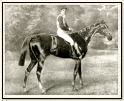 |
Clorane
|
|
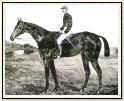 |
Come Away
|
|
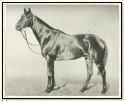 |
Glen Albyn
|
|
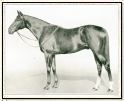 |
Irish Elegance, Clorane's grandson through daughter Sweet Clorane
|
|
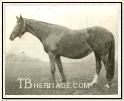 |
Kendal Belle
|
|
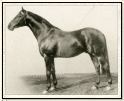 |
Prospector
|
|
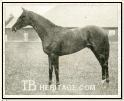 |
Shogun
|
|
|
Clorane ch.c. 1891
(Castlereagh- May Girl by Victor)
Clorane, bred by J.G. Hartigan, who was first located at Ballingillough in Kilmallock, and then at Manister House, Crooom, Limerick, won three races in Ireland, including the Cork Derby, before his purchsae by A.F. Bassett, after which he was brought to England. In England he won at Leicester and Derby, the Kempton Park Easter Handicap, the Great Cheshire Handicap, and on the same day, the May Plate. He won Ascot's Royal Hunt Cup by "the shortest of heads" over Victor Wild. He also easily won the Lincolnshire Handicap, carrying 9 st. 4 over that tough mile course. In 1897, his last year, he won Derby's Doveridge Handicap, giving the second runner 38 pounds, and then was retired to stud. In all, he won thirteen races. His sire, Castlereagh, was a son of Speculum. His dam, the unplaced May Girl, was by Victor, who won the Ascot Hunt Cup and was a great sire of of hunters and steeplechasers in Ireland.
In the stud Clorane got nine winners, his best being Morris Dancer, winner of £1,463. Clorane died during his second season at stud in 1899. Clorane's daughter, Sweet Clorane (1900), out of a registered thoroughbred mare, Tiny Twin, by Tertius, was a winner of one race, and proved to be an outstanding producer, although because of Clorane, none of them were eligible for entry in the GSB. Her offspring included Peace Declared (1918), a winner of five races; Scottish Elegance (1920), a winner of two races; Irish Elf (1919), a winner of two races; Arthur B. (1911) a sire of winners in India; Cloringo (1921) winner of the National Hunt Steeplechase at Cheltenham; and Irish Elegance, a big, handsome chestnut colt, the greatest miler of his day, by the relatively indifferent sire, Sir Archibald. Owned jointly by James White and A.L. Ormrod, who paid an unprecedented £10,000 (for a half-bred) for him, Irish Elegance ran third in the Cambridgeshire of 1918, and in 1919 won the six length Salford Borough Handicap at Manchester, four days before his great victory in the Royal Hunt Cup, carrying 26 pounds more than the second place runner and completing it in the fastest time recorded to that date. He was retired to stud that year at Foxhill Stud, near Swindon, Wilts., where he was fully booked his first year at a fee of 200 guineas. He doesn't actually belong to the family in tail-female, but his picture is reproduced here.
Come Away b.g. 1884
(Cambuslang - Larkaway by Royal Oak Day)
Bred and trained by Harry Beasley at Eyrefield House on the Curragh in Ireland, where he was highly successful over fences; he ran a total of ten races during his career, winning eight of them, including the Grand National, the Conyngham Cup, and the Valentine Chase at Liverpool. He was sidelined for 18 months during his four year old season, when he had suspensory problems, but came back to win four of his five races at age six. He only contested the Grand National at Aintree once, in 1891, against an excellent field which included future National winner Cloister, 1890 winner Ilex, 1887 winner Gamecock, and 1884 winner Why Not, among other good jumpers; he came up lame after his victory, and the National was his last race. His dam, Larkaway, bred at the famous Knockany Stud in Limerick by Captain Gubbins, won six steeplechases, and produced four winners for Knockany after which she was sold for 40 guineas to T.D. Hoey. Her 1880 daughter, Coquette, a winner of three races, and Come Away were bred by Harry Beasley. Come Away's second dam, Luna, bred by C. Massey in Co. Tipperary, won the Kilcock Steeplechase in two heats out of three, the Kildare Hunt Steeplechase over three miles, and the Dublin Car-owners' Challenge Cup over three miles in Ireland.
Duc-an-Dhurras br.c. 1845
(Molyneux - Calamity by Vampyre)
Owned by the Marquis of Waterford, of Curraghmore, one of the most prominent sportsmen in Ireland in his era, Duc-an-Dhurras was a 15.3 hand horse celebrated for his 21 wins on the turf and his later success as a stallion. He and his half-brother, Garibaldi (by Faugh-a-Ballagh) were the first to bring this family into prominence; Garibaldi won ten races and two steeplechases. An unnamed half-sister by Harkaway produced five foals, all winners, including Good Boy, winner of Ireland's National Produce Stakes, the Quack, winner of one race, Marksman, winner of fifteen races and later a good hunter sire, Lothian's Hunt Cup winner Mortality, and the ill-fated Aurora Leigh, undefeated in six starts, but falling and breaking her neck in her first hurdle race, her seventh start. Another filly out of Calamity and by Harkaway was the unraced Stirrup cup, dam of Vandal, a winner of the Thirsk Cup and four other races. Some foals of Duc-an-Dhurras were included in Vol. IX of the GSB, with the caveat printed "It has always been considered doubtful if Duc-an-Dhurras is thoroughbred, but as several of his foals appear in the preceding pages, and we have not ventured to call them half-bred, we think it is better to give the pedigree of this horse as far as it is known."
Glen Albyn b.c. 1923
(Bridge of Earn - Alarmed by Santoi)
Won four races in England, including the Redcar Handicap, before being shipped to South Africa in 1927 by owner Sol Joel, who had extensive racing and business interests there. Typically during this period, geldings and horses were imported into South Africa specifically to contest the rich handicap races; Glen Albyn did not disappoint Joel, in 1928 winning a Germiston Handicap worth £400, the Johannesburg Autumn Handicap (£1,750), and the prestigious Durban July Handicap (£6,000, setting a track record), and other good races there; in 1927-28 he led the lists in highest earnings. His dam won once and placed second twice in her races at age three, her only season. She also produced the grey filly Awning, by Royal Canopy, a winner of three races, and an unnamed colt by a Royal Canopy son, Royal Fright, that won one race.
Kendal Belle ch.f. 1893
(Kendal - May Day by Uncas)
Kendal Belle, bred by John Gubbins at Bruree, Co. Limerick, ran once, unplaced, in England as a juvenile. She entered the Gubbins Bruree stud at age three, and passed on to the ownership of the Browning brothers after Gubbins' death in 1906, and after 1912 was owned by D.R. Browning and Major Frank Wise. She had an excellent shoulder and length of rein, and good bone. She was dam of ten winners from eleven foals, including the brilliant Prospector (see below); Shogun (see below); Forerunner II, winner of the Wokingham Stakes, The Hull Cup, and the Grand Criterion d'Ostende, and three other races; Belfast (2 flat races, 2 hurdle race, and 2 races in Germany). Her daughters included the speedy Caravel, winner of ten races in thirty starts, and second six times, and third three, later dam of two winners; Belle of Bruree, winner of Liverpool's Joliffe Stakes, later dam of Magical Maid, a winner of three races and dam of winners, including Magic Maid, winner of four steeplechases; Belle of Knockany, placed in two flat races and winner of a small race over hurdles; The Dhow, winner of the Michaelmas Stakes and second in the Michaelmas Plate in seven starts over three seasons, dam of two winners; Toy Belle, winner of two races, who died at age three; Arctic Belle, winner of one flat race in fourteen starts, and placed three times in six starts over hurdles; Polar Belle, unplaced in six starts, but dam of winners on the flat and over fences.
May Boy ch.c. 1880
(Xenophon - May Day by Uncas)
May Boy, by Xenophon, was a famous Irish runner on the flat and over fences. He won the Waterford Testimonial, the Beresford, Purdysburn, and Downshire Stakes, four Queen's Plates, and the Sandown Nursery in England and Ireland, and won the Auteuil Hurdle Race (in France), in all winning eleven of his 23 races on the flat, and two of his five races cross-country. He was a famous sire in Ireland. His son Chit Chat, won the Scottish Grand National and good races on the flat, and Chit Chat's brother, Chatterbox won the Baldoyle Derby, two Queen's Plates over three miles, and the Royal Whip. May Boy's daughter, Sister May, bred by Gubbins in 1888, from the thoroughbred Springfield daughter Wood Sorrel, was a winner on the flat and in the stud produced good steeplechasers, including the Grand Sefton steeplechase winner Phil May, and Little May, winner of the Drogheda Plate, the Irish International Steeplechase, and the Southern Plate. He got many other good runners on the flat and over fences, and good producing daughters. He was sold to Hungary in 1898, but died enroute.
Prospector b.c. 1905
(Pioneer - Kendal Belle by Kendal)
Fastest colt in England when a juvenile, he was a sound and sturdy sprinter, winner of the Coventry Stakes (in a canter), Hurst Park's Surrey Stakes, and Bilbury's Hurstbourne Stakes, and was second to Olympus in Newbury's Kennet Plate as a juvenile. At age three, in eight starts he won Kempton Park's Princess Plate (5 furlongs), and was second three times, to Americus Girl in the Fern Hill Stakes (5 furlongs), to Ignorance in the Champion Spring Race at Hurst Park, and to Bellatrix in Kempton's Richmond Plate. At age four he ran twelve times, winning the Thames Handicap at Windsor, and placing second in the Beaufort Handicap (5 furlongs) and the Surbiton Handicap at Sandown (5 furlongs), conceding anywhere from 6 to 43 lbs. to his opponents. He contracted an illness that left him a roarer. Sired Impertinent, Quarryman, La Paloma, and other winners in the U.K., many precocious juveniles like himself, South African winner Argus, and some winners in India.
Shogun ch. c. 1910
(Santoi - Kendal Belle by Kendal)
Bred in Ireland by the Browning brothers, the handsome chestnut Shogun, who bore a strong resemblance to his dam, was purchased for 2,000 guineas as a yearling at the Doncaster sales by Sir Edward Hulton. Hulton was the publisher of the Sporting Chronicle, the Sunday Herald, the Evening Standard and other newspapers in the U.K., who first raced horses in 1906. Shogun looked to be a strong classic contender at the end of his juvenile season, having won five of his eight races and placing second in the other three. His wins that season included the Hyde Park Plate, the Woodcote Stakes, the Coventry Stakes, the Fulbourne Stakes and the Lavant Stakes, and was second to Craganour in the New Stakes, Champagne Stakes and Middle Park Plate. At age three, did not place in the 2,000 Guineas, but started second favorite for the "Suffragette" Derby, where traffic on the rail caused him to be eased twice and he ran sixth; many later considered him unlucky to have been beaten. Later that year he won Newbury's Greenham Stakes, the Ascot Gold Vase and Liverpool's Knowsley Dinner Stakes. He broke down before the running of the St. Leger, and was retired to stud at Hulton's Warren Tower paddocks at Cheveley, Newmarket. He sired a number of winners, some of which won in India and South Africa, but his most significant offspring was the race mare and producer Verdict (Family B - 3). He died early, age ten.
|
|
Roseden Mare (f 18--) by Rosden
Whitenose Mare (f 18--) by Whitenose
Vanity (ch.f. c182-) by Spartacus
Calamity (b.f. 1840) by Vaympyre
| Duc-an-Dhurras [Dioch-an-Diorrhuia] (br.c. 1845) by Molyneux
| Mare (f. c1847) by Harkaway
| | Good Boy (b.c. 1857) by Bryan O'Lynn
| | The Quack (ch.c. 1858) by Dr. O'Toole
| | Marksman (b.c. 1861) by Artillery
| | Aurora Leigh (b.f. 1863) by The Trapper
| | Mortality (b.f. 1864) by The Trapper
| Stirrup Cup (f. c1849) by Harkaway
| | Vandal (ch.c. 1857) by Barbarian
| Mare (f. 18--) by Black Prince
| Garibaldi (ch.c. 1856) by Faugh-a-Ballagh
Luna (ch.f. 1845) by Harkaway
Fairy Saint (ch.c. 1856) by Young Tipple Cider
Larkaway (ch.f. 1864) by Royal Oak Day
May Boy (ch.c. 1872) by Conjuror or Stockman
May Day (ch.f. 1874) by Uncas
| Mayboy (ch.c. 1880) by Xenophon
| May Girl (b.f. 1881) by Victor
| | St. Marie (br.f. 1886) by Sheldrake or Mackintosh
| | | Lady Hack (b.f. 1894) by Castle Hack
| | | | Gift V (ch.f. 1901) by Glenvannon
| | | | Silver Blaze (ch.c. 1906) by Maltravers
| | | Kilgrogan (b.c. 1896) by The Rejected
| | | Sweetbriar (b.c. 1898) by Sweetheart
| | | Bijou II (b.c. 1899) by Blairfinde
| | Clorane (ch.c. 1891) by Castlereagh
| | Manister (br.f. 1892) by Tacitus
| | | Lord Worman (br.c. 1900) by Worcester
| | | Dollanstown (b.c. 1901) by Diakka
| | Glenartney (b.c. 1895) by Glenvannon
| | May Lassie (b.f. 1894) by Glenvannon
| | | Mare (b.f. 1908) by Barcadaile
| | | Hollyford (ch.f. 1921) by Marten
| | Carrigeen (ch.c. 1898) by Atheling
| | Mimosa (ch.f. 1904) by Santoi
| | | Destine (b.f. 1911) by Desmond
| | | | Money Glass (1917) by Rising Glass
| | | | Resurgam (b.f. 1920) by Rising Glass
| | | | The Future (ch.c. 1921) by Glasgerion
| | | | Phantasy (br.f. 1925) by Fantomas
| | La Hogue (f. 1917) by Littleton
| | | Treasure Island (br.c. 1925)
| | | | Fair Sex (gr.f. 1927) by Poltava
| | Santon (b.c. 1905) by Santoi
| May Moon (ch.f. 1885) by Philammon
| | Moonlight Flit (br.c. 1894) by Adieu
| | Silvery Moon (ch.f. 1895) by Hampton
| Queen May (b.f. 1886) by Philammon
| | Mayberry (b.f. 1894) by Kendal
| | | Mare (ch.f. 1898) by Winkfield
| | | | Willie Bulfin (ch.c. 1909) by Admirable Crichton
| | | | May Winkfield (f. 1913) by Oppressor
| | | | Second Flight (ch.c. 1925) by Ballincolloo
| | | | Mayfield (b.f. 1926) by Gallio
| | | May Grey (br.f. 1903) by St. Gris
| | | | Don Quichotte II (br.c. 1920) by Don Juan
| | | Mayfowl (c. 1905) by Wildfowler
| | | Royal Berry (br.c. 1900) by Buckingham
| | | Mayfly IV (b.f. 1907) by Speed
| | Pride of May (b.f. 1897) by Milner
| | Royal Hackle (b.c. 1900) by Hackler
| Assessor (br.c. 1887) by Arbitrator
| Garland (ch.c. 1888) by Charibert
| Knockany (ch.c. 1880) by Kendal
| Castle May (ch.c. 1802) by Castlereagh
| Kendal Belle (ch.f. 1893) by Kendal
| Belle of Bruree (b.f. 1897) by St. Florian
| | Magical Maid (b.f. 1909) by Fariman
| | Magic Maid (ch.f. 1916) by His Majesty
| | | Peggie's Pride (ch.c. 1923) by Tidal Wave
| | | Dingle Maid (ch.f. 1927) by Ding How
| | Glamis Maid (b.f. 1922) by Thistleton
| | Magic Thistle (br.f. 1923) by Thistleton
| | Kilskyre (br.c. 1927) by Meleanger
| Belle of Knockany (b.f. 1899) by St. Florian
| | Eileandonan (bl.c. 1924) by Jackdaw
| | Ardelve (b.c. 1926) by Jackdaw
| | Belle Bird (br.f. 1927) by Jackdaw
| Caravel (b.f. 1900) by Pioneer
| | Filibuster (b.c. 1908) by Wildfowler
| | Shipshape (ch.f. 1910) by Cicero
| | Little Curragh (f. 1920) by Juggernaut
| The Dhow (br.f. 1902) by Pioneer
| | Sion (ch.f. 1907) by Orvieto
| | Solprufe (br.c. 1910) by Joe Chamberlain
| | Stretchworth Belle (b.f. 1911) by Joe Chamberlain
| | | Rose L. (1916) by St. Victrix
| | | Torbelle (br.f. 1924) by Torloisk
| | | Judy Bridge (ch.f. 1925)
| | | Rose Pink (b.f. 1926) by Rose Prince
| | | Sandy Lashes (ch.c. 1928) by Happy Man
| | Polydhow (f. 1914) by Polymelus
| | Blinky Dhow (br.f. 1921) by Blink
| | | Groping (ch.f. 1928) by Right Arm
| | | Downright (br.c. 1929) by Right Arm
| | Baulking (ch.c. 1922) by Phaleron
| | Reina Mora (b.f. 1923) by Vexillum
| | Polyphonta (br.f. 1927) by Our William
| Fore-Runner (b.c. 1904) by Pioneer
| Prospector (b.c. 1905) by Pioneer
| Belfast (ch.c. 1906) by Vitez
| Toy Belle (b.f. 1907) by Santoi
| Arctic Belle (ch.f. 1908) by Pioneer
| Polar Belle (ch.f. 1909) by Pioneer
| | Sanbella (1918)
| | Polar Lass (f. 1920) by Junior
| | First Offence (ch.c. 1924)
| | Go Easy (b.c. 1926) by Stratford
| | Polar Bear (b.c. 1927) by Stratford
| | King Oscar (br.c. 1928) by Torlonia
| Shogun (ch.c. 1910) by Santoi
| Night Bell (b.f. 1912) by The White Knight
| Alarmed (br.f. 1916) by Santoi
| | Awning (gr.f. 1922) by Royal Canopy
| | Glen Albyn (b.c. 1923) by Bridge of Earn
| | No Fear (ch.f. 1927) by Bridge of Earn
| | Careful Sailor (ch.c. 1928) by Bresford
| Santabel (b.c. 1919)
| Bridgestown (b.c. 1924)
| Lady Doctor (b.f. 1928) by Beresford
| Sherwood Knight (ch.c. 1930) by Sherwood Star
May Bloom (ch.f. 1875) by Uncas
Prospect (ch.f. 1876) by Xenophon
| Kaiser (ch.c. 1886) by Monarch of the Glen
Funny Eyes (ch.f. 1877) by Uncas
Mare (f. 1883) by Xenophon
| Greek Girl (b.f. 1883) by Goldhill
| Greek Man (ch.c. 1886) by Goldhill
| Greek Lad (b.c. 1888) by Goldhill
| Greek Bird (b.c. 1893) by Bird of Freedom
| Greek Boy (b.c. 1895) by Winkfield or Bird of Freedom
Coquette (ch.f. 1880) by Cambuslang or Umpire
Mare (f. 1883) by Cambuslang
| Au Revoir (ch.f. 1892) by Favo
| Moyfenrath (b.f. 1895) by Ascetic
| | Jock (b.c. 1905) by Freemason
| Hill of Bree (b.c. 1896) by Ascetic
| Sandy Bree (ch.f. 1897) by Ascetic
Come Away (b.c. 1884) by Cambuslang
|
|
|

